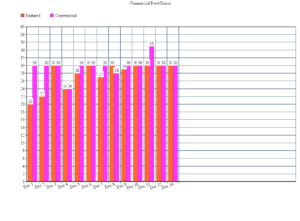2016 Annual Report for FW16-030
Rotating Paddock-style Systems in Tropical Environments
Summary
Poultry and egg production on Guam has been limited to backyard and small farm production. All larger production farms have shut down operations and have closed due to adverse weather, degradation of facilities and increased feed costs. Guam imports 95% of all its consumables. Fuel surcharges continue to increase, the result is an increase of those consumables. As the price of feed continues to rise it becomes increasingly difficult to operate a small poultry farm. Feed cost consist of well over 30% of farm cost.
Vegetable and fruit production are the larger percent of agriculture industry on Guam. The increase cost of material and supplies also influence horticulture farms. All fertilizers sprays and manures are all imported. Fertilizers are heavily used because of the lack of Nitrogen components in the islands soils.
This project was designed to combine poultry egg production and small scale vegetable production using a paddock style rotation. Moving poultry stock to new pasture at correct time intervals can reduce commercial feed input by open grazing and leaving manure residue resulting in minimum or no added fertilizers to soils. Problems with conventional poultry design to include high concentrations of manures resulting in ammonias and other gases unhealthy to the livestock and human counterparts.
Pullets being used for this project arrived Guam on August 12 2016. Three hundred were separated in two different brooders. At 1 month pullets were put on the ground. October new hen house completed. At 2.25 months pullets were separated into perspective locations. Total mortality rate to this point was at 15 percent. Preliminary Pasturing of hens began at 4 months. Observation of feed usage begins. Current age of Hens are at 5 months. Anticipation of egg production is at 6 months. Project will also conclude egg production quantity differences and product quality with two different practices. The next phase of this project will conclude outcomes and challenges and can educate the islands community on economic sustainability through proper production management.
Budget Expenditures to date, New Pullets $1095.00, Materials and Supply $2501.32. Commercial Feed $3211.50. Labor $600.00, Total $7502.82
Objectives/Performance Targets
1. Determine feed consumption and cleanup times to reduce feed input and maximize available pasture.
2.Establish and manage small scale vegetable crop production through use of livestock manure deposits and their ability to control pests while improving environmental and soil fertility conditions.
3.Showcase the importance of livestock production through pasture management decreasing the need and use of commercial feed.
4. Provide an easy step by step guide on efficient poultry and egg production for local farmers and producers through planned field survey days when egg production stabilizes.
Accomplishments/Milestones
* We were able to obtain larger brooders through the availability of discarded crates from a local renewable energy company. This lead to less stress and over crowding of pullets.
 New Brooder
New Brooder  Brooding Stations
Brooding Stations

*October 2016 New hen house complete, designed with adverse weather in mind (typhoons). Steel pipe was used and roof brought closer to ground.
 New Hen House
New Hen House  Complete House for pastured hens
Complete House for pastured hens
*November 2016, 4 month old pullets were put into a 2100 sqft pasture and left for a month to determine the amount of time it took to clear the paddock. This will give us a guideline on the correct time rotate into a new area and when they become more reliant on commercial grain. Result was area completely clear of available pasture within 2.5 weeks and crops could be planted at just 3 weeks. Visible manures spread across complete area.
 Preliminary results. 1 month
Preliminary results. 1 month  New pasture rotation
New pasture rotation
*Through documentation of commercial feed given. Dec 2016 and Jan 2017, Morning feedings of commercial feed and open to new pasture. A large portion of the hens preferred moving to new paddock with fresh pasture eventually cleaning feeders later in the day or not cleaning them at all. Ten pounds of feed is given three times a day at 30 lbs max as ration. If there is still existing feed, feeders are topped off. Proving the ability to reduce commercial feed.
 Feed variation
Feed variation
Impacts and Contributions/Outcomes
Labor Hours-Through documenting both conventional and pastured poultry production, we have concluded there is a considerable more amount of labor hours involved with maintenance. This is due to manure concentration build up in the facility. It takes a minimum of 4 hours to remove soiled straw, replace with new material and clean ventilation screens . This needs to be done twice a month.
Feed Cleanup- Conventional vs Pastured, If hens are given fresh pasture it will take a considerable more amount of time for them to completely finish commercial feed rations. If pastured hens are not moved in a timely manner pasture time decreases and feed cleanup time can vary between the two systems. Usually matching one another. It is very important to follow a rotation schedule and to observe the activity of the hens.
Coconut- We have implemented the use of fresh split coconut in both locations. This helps with commercial feed costs and gives a healthy alternative of food stuff. Cleanup time varies with each location.